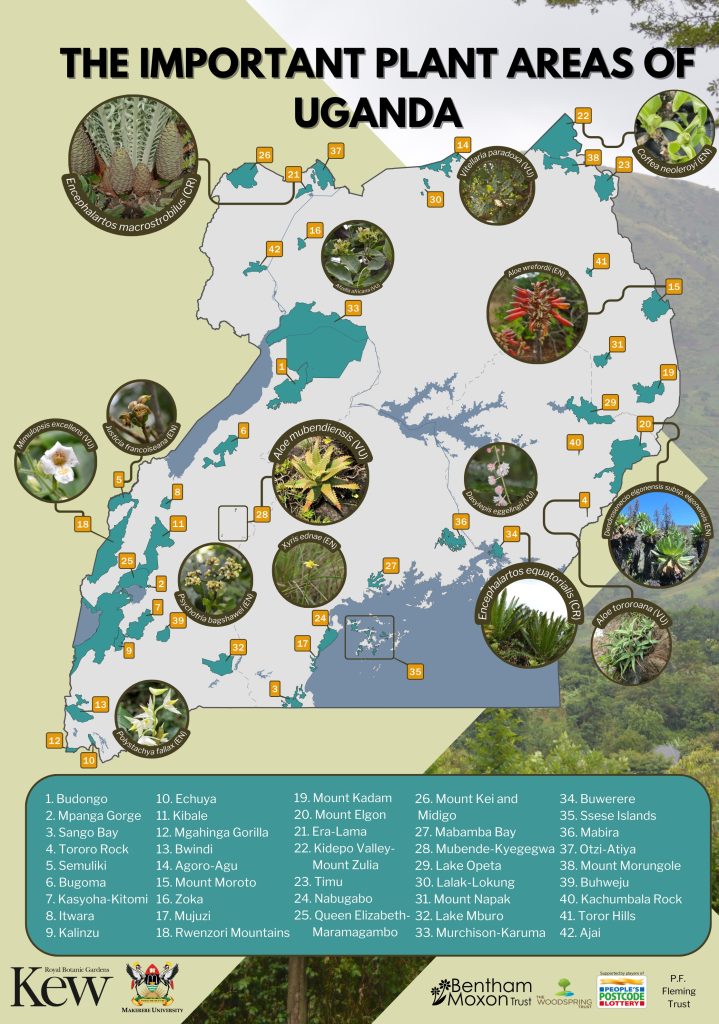pr.cns@mak.ac.ug
Uganda Identifies 42 Important Plant Areas for Conservation

Uganda has taken a significant step towards the conservation of its unique plant diversity by identifying 42 Important Plant Areas (IPAs)—critical sites that require urgent conservation action to protect priority plant species. The initiative, spearheaded by Makerere University in collaboration with the Royal Botanic Gardens, Kew, United Kingdom, marks the first time the IPA concept has been applied in Uganda, aligning the country with global efforts, particularly the Global Strategy for Plant Conservation of the Convention on Biological Diversity (CBD), to safeguard plant diversity.
The identification of these sites was based on three global criteria: the presence of threatened species, exceptional botanical richness, and threatened habitats. Among the designated IPAs are well-known protected areas such as Semuliki, Lake Mburo, Murchison Falls, Kibale, and Bwindi Impenetrable National Parks as well as Mabira, Budongo, and Kashoya-Kitomi Central Forest Reserves . However, several identified sites remain unprotected, including Tororo Rock, Buwerere, Kacumbala Rock, and Buhweju, highlighting the urgent need for conservation efforts beyond Uganda’s formal protected area network.
A Call for Urgent Conservation Action
Uganda is home to a rich and diverse plant life, ranging from the semi-arid landscapes of the northeast to the lush montane rainforests of the southwest. Despite covering only 2 percent of the world’s land area, the country boasts an impressive array of flora that serves as a foundation for food security, medicine, water conservation, and biodiversity sustenance. However, the country’s fast-growing human population and increasing demand for land have resulted in widespread deforestation and other forms habitat destruction, threatening many of the priority species.
Speaking about the initiative, Ugandan botanists Prof. James Kalema and Dr. Samuel Ojelel from Makerere University’s Department of Plant Sciences, Microbiology, and Biotechnology emphasized that prioritizing these sites provides an effective strategy for focusing conservation efforts where they are most needed. “It is impractical to protect every species everywhere, so identifying and safeguarding key plant areas ensures that the most threatened species and habitats receive the attention they deserve,” they said in a joint statement.
Beyond Protected Areas: Engaging Communities for Conservation
While Uganda has made remarkable strides in biodiversity conservation, with 10 National Parks, 12 Wildlife Reserves, and 506 Central Forest Reserves, more than 50 percent of the country’s wildlife resources lie outside protected areas. Many of the newly identified Important Plant Areas fall within unprotected landscapes, increasing the risk of destruction due to human activities such as agriculture, logging, and mining.
To address this challenge, conservationists are calling for meaningful engagement with local communities and private landowners to ensure the protection and sustainable use of these critical plant species. This includes efforts to restore degraded habitats, promote agroforestry, and create incentives for conservation-friendly livelihoods. “The success of this initiative will depend on the involvement of local communities, as many of these important plant species exist on land that is not under formal protection,” said Prof. Kalema. “We must work hand in hand with frontline communities to ensure that conservation efforts benefit both biodiversity and livelihoods.”
A Step Forward for Uganda’s Conservation Goals
The identification of Important Plant Areas adds to Uganda’s growing commitment to conservation and aligns with global biodiversity targets, including the United Nations Sustainable Development Goals (SDGs) and the Convention on Biological Diversity (CBD). It also complements existing conservation frameworks such as Key Biodiversity Areas (KBAs), Important Bird Areas (IBAs), and Ramsar Sites.
The initiative underscores Uganda’s strategic role in safeguarding the world’s plant diversity and provides a scientific basis for targeted conservation interventions. With continued support from research institutions, conservation organizations, and government agencies, experts hope that these newly identified IPAs will receive the legal and community-based protection needed to thrive.
The Way Forward
As Uganda moves forward with its plant conservation agenda, the two researchers at Makerere University and their international partners, particularly at Kew, Dr Iain Darbyshire, Sophie Richards and Haley Gladitsch, have recommended:
- Strengthening policies to formally recognize and protect Important Plant Areas.
- Engaging communities in conservation efforts through awareness campaigns and sustainable livelihood projects.
- Restoring degraded plant habitats and promoting sustainable land-use practices.
- Encouraging further research on Uganda’s rich plant diversity to update conservation priorities.
The recognition of Important Plant Areas is a crucial step in ensuring that Uganda’s flora is preserved for future generations. However, its success will depend on sustained conservation efforts, funding, and community involvement. As the country balances development and conservation, initiatives like this provide a model for protecting biodiversity while supporting human well-being.
By Dr. Samuel Ojelel & Prof. James Kalema
Department of Plant Sciences, Microbiology and Biotechnology, Makerere University



